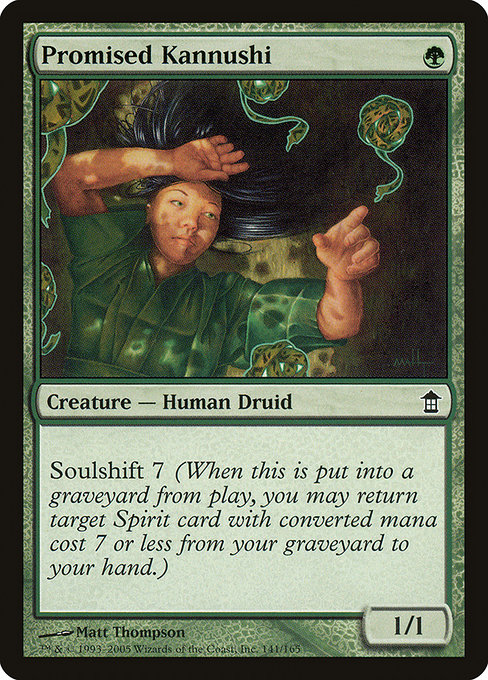
Image courtesy of Scryfall.com
Meta-Aware Card Design: Lessons from a Kamigawa Classic
In the evolving landscape of Magic: The Gathering, the best cards aren’t just about numbers on a sheet—they’re conversations with the broader ecosystem. Promised Kannushi, a green 1/1 Human Druid with Soulshift 7 from Saviors of Kamigawa, is a quiet but telling example. For a card that costs a mere {G}, you get a tiny body with a big idea: death isn’t the end of a story, it’s a doorway to something you crafted earlier in the game. When Kannushi dies, you may return a Spirit card with mana value 7 or less from your graveyard to your hand. That interaction—a flexible, value-driven trigger that ties graveyard strategy to a predictable threshold—illustrates the core appeal of meta-aware design: cards that age gracefully with the format’s evolving strategies. 🧙♂️🔥
Released in 2005, Kannushi sits in the Saviors of Kamigawa (SOK) set as a common green creature. The green color identity, the Spirit theme of Kamigawa’s block, and the low initial risk of casting a 1/1 all combine to make a design that rewards patient planning. Its Soulshift keyword—an older mechanic focused on returning Spirit cards from the graveyard to your hand—creates a recognizable micro-arena: the graveyard as a second hand. In a modern meta where reanimation, tribal synergies, and graveyard interactions rise and fall with every rotation, Kannushi acts as both a reminder and a blueprint for how future cards can honor past mechanics while staying thrillingly relevant. 🎲
Soulshift and the Ghosts of Kamigawa
Soulshift is more than a gimmick; it’s a design philosophy about recursion and momentum. When Kannushi dies, you’re not simply losing a 1/1; you’re triggering a potential recapture of a Spirit, a move that can swing the tempo over multiple turns. That door is particularly enticing in deck archetypes built around Spirit tribal or graveyard recursion, where every layer of interaction adds a new axis for decision-making. If a player already controls a few Spirits with mana value 7 or less—Think of the archetypal Spirit toolbox from Kamigawa’s era—the Kannushi window becomes a reliable plug-in that maintains pressure even after a small setback. This is the kind of design that invites deck builders to imagine cross-temporal synergies, where a 2005 card can find relevance alongside 2020s mechanics. ⚔️
“In meta-aware design, every card isn’t just about today’s play—it’s about tomorrow’s conversations at the table.”
The elegance of Kannushi’s spell-out lies in its simplicity: a single green mana leads to a layered choice. Do you want a Spirit card back now, or do you hold the possibility for a later, harder-to-predict moment? The mechanic nudges players toward mid-game planning without forcing a heavy-handed path. That balance—ease of entry with a path to deeper strategy—is a hallmark of thoughtful meta-aware design. As designers, we increasingly look for cards that encourage this kind of layered decision-making, especially in a game that rewards both long-view strategy and opportunistic plays. 🧙♂️🎨
From One Card to a Living Design Space
What Kannushi demonstrates is a principle that resonates across the MTG design pipeline: build around a core mechanic in a way that remains legible across formats and eras. Soulshift’s retroactive recursion invites players to consider not just what a card does on the battlefield, but what it enables in the graveyard, the hand, and the cycle of play itself. In today’s design ethos, a meta-aware card should feel like a conversation between sets—acknowledging older engines while offering new routes to win. Kannushi’s green, low-cost footprint makes it a natural bridge between early Kamigawa-themed spirits and modern graveyard strategies, a design thread that future cards can extend or subvert. 💎
For players, this means thinking not just about the immediate impact, but about how a card’s death can seed future turns. For designers, it signals a path where a single keyword can unlock a family of interactions that persist beyond a single game. The future of meta-aware design lies in creating cards that reward you for remembering history while empowering you to innovate in the present. When you pair a simple body with a powerful, stackable mechanic like Soulshift, you get something that ages with grace—just like a classic card that remains a staple in the right archetype. 🧙♂️⚔️
As the MTG universe continues to expand, the conversation around meta-aware card design will likely emphasize cross-format viability and player-facing storytelling. Kannushi is a reminder that a well-timed death can be a doorway to resurgence, not a conclusion. In a broader sense, it’s a nudge toward thinking about how future cards might weave history into new realities—encouraging players to chase not just victories, but the joy of noticing intelligent design that rewards memory, planning, and a little bit of luck. 🎲
For readers who want to explore more real-world implications of meta-aware design and strategy, this piece nods to a broader ecosystem of insights. If you’re curious to dive deeper into how currencies, branding, and community engagement intersect with MTG’s evolving landscape, check out the linked articles below. Each piece adds a layer of context to how players, collectors, and creators navigate this vibrant hobby. 🔥🎨
Designing with an eye toward the long arc—where a card’s identity spans formats and eras—means embracing both nostalgia and novelty. Promised Kannushi embodies that duality: a small, elegant card with a big idea, a spark that helps illuminate the future of meta-aware MTG design. And who knows what spirits might rise again in future sets when a faithful Kannushi guides the way? ⚔️🧙♂️
Product spotlight: keep your gear protected as you plan your next big strategy session. The Rugged Phone Case: 2-Piece Shock Shield is ready for travel, tournaments, and late-night deckbuilding marathons. Rugged Phone Case: 2-Piece Shock Shield 🧙♂️
More from our network
- https://crypto-acolytes.xyz/blog/post/gaming-currencies-vs-meme-tokens-which-holds-real-value/
- https://blog.digital-vault.xyz/blog/post/silkguard-mastering-mid-game-tempo-in-mtg/
- https://blog.digital-vault.xyz/blog/post/inferno-jet-ignites-mtg-crossover-demand-among-non-mtg-collectors/
- https://blog.digital-vault.xyz/blog/post/from-users-to-advocates-turning-customers-into-brand-ambassadors/
- https://crypto-acolytes.xyz/blog/post/efficient-minecraft-pumpkin-and-melon-farm-guide/